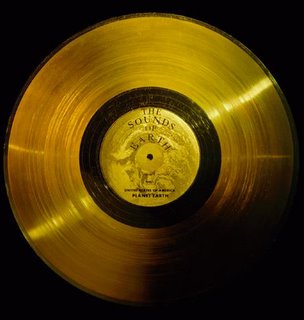 I was seven years old when Voyager I was launched in 1977; not old enough to understand all the complexities of such a mission, but the perfect age to be filled with curiosity and wonder. Now 36, I've been fascinated with this mission for nearly all of my life. Very recently, the Voyager probe finally broke free of the Sun's influence, past what scientists call the 'termination shock', far away from where we sit today in front of our computers. 8.8 billion miles, to be exact. Other probes have also left the solar system in this manner, but none has had such a profound, lifelong effect on me, perhaps due in part to its precious cargo.
I was seven years old when Voyager I was launched in 1977; not old enough to understand all the complexities of such a mission, but the perfect age to be filled with curiosity and wonder. Now 36, I've been fascinated with this mission for nearly all of my life. Very recently, the Voyager probe finally broke free of the Sun's influence, past what scientists call the 'termination shock', far away from where we sit today in front of our computers. 8.8 billion miles, to be exact. Other probes have also left the solar system in this manner, but none has had such a profound, lifelong effect on me, perhaps due in part to its precious cargo.Back when I was seven, what was most interesting to me wasn't the way the probe was going to record and relay back to Earth information about the planets of our solar system, but rather the gold disc that was attached to the outside of the craft containing scientific, genetic, anatomical and biological information along with greetings from Earth in 55 languages. What was, and still is so exciting to me is the idea that this scientific probe with all its technology to photograph, record, and transmit data back to Earth from what is basically our cosmic front porch was engineered to eventually be catapulted by gravity out of the realm of our familiar surroundings, past Pluto and drift endlessly into the depths of space containing a simple but profound message from the human race; our message, in a bottle adrift in the interstellar ocean.

THE GOLDEN RECORD
Already outdated by today's technology standards like multi-gigabyte mp3 players, flash memory and compact hard drives, the iconic pop-culture image from the 1970's was a gold gramophone record that was attached to Voyager containing our messages and data that will nevertheless will get the job done, if given the opportunity. The late, great Carl Sagan led the team that assembled a wide variety of sounds that represented a little bit of life on Earth, from crickets chirping to the blast of a Saturn V rocket launch. Also included on the disc: images, music, and of course the greetings I mentioned above.
What a concept! The possibility of 'someone' finding Voyager floating along in the depths of space is extremely, ridiculously remote, so the act of including the disc was meant more as a statement than a calculated attempt at the ultimate return on investment. But still, what an outstanding statement borne of our humanity and this place we all share together; our planet.
I'm grateful that a group of people were bold enough to think outside the cold scientific objective of the Voyager mission which was to gather data about our solar system. What Sagan and his team did was simple and taboo, even today -- to blend science with humanity. Will someone or something ever encounter Voyager? Maybe. But what's more important to consider is that we all share our planet, we are all one race. Variables we toil and struggle over in politics, culture, language and societies will always exist, maybe even on other planets, but if we remember that in comparison to the grand machine that is the universe as a whole, those differences are minute.

It will take approximately 40,000 years for Voyager to drift within range of the nearest star to us, with nothing in between but emptiness. Let your mind drift for a moment and consider what would happen if another civilization found the craft with its precious cargo of Earthly information, pinpointed us on the stellar map included on the disc, and set forth to visit us. 40,000 years from now, what will Earth be like? What governments will exist, if any? What role will technology play? Will technology evolve into a unique and individual intelligent species of its own?
Will our home even be inhabited by intelligent life at all?
Sagan often said that we are at an incredibly momentous time in human history. For the first time ever we have both the technology to save and improve life, or utterly destroy it forever in a flash. Think of that for a moment, the human race gone forever.
The choice we face as one race, one human race, is whether we will leave a barren, lifeless planet drifting through space with only a few hardened primitive lifeforms that somehow survived the catastrophic horrors of nuclear war, or whether we will leave a lush, rich planet teeming with life and inhabited by our own ancestors to greet any visitors who may happen across our interstellar invitation.
I hope and pray with all my heart, as I know many others do including the late Dr. Sagan that humans somehow put aside all our political adversities, all social and religious intolerances, let go of our schemas of greed and self destruction and realize that we do have a very real choice to make, a choice more important than any ever made in the history of this planet.



